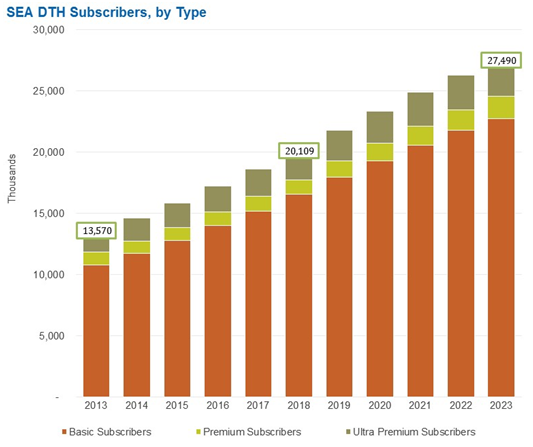|
|
Southeast Asia
DTH: ASEAN to Behold
Sep 3rd, 2014
by
Alan Crisp, NSR
The Indian
DTH market justifiably
captures a hugely
disproportionate number
of headlines when
discussing ‘growth
drivers’ for
Direct-to-Home (DTH)
subscribers and
revenues. India recently
became the largest DTH
market in the world by
subscribers, and every
month it seems some
major press release or
development comes from
the subcontinent.
However, often what is
lost in all of this
excitement is the
relatively smaller, but
arguably even better
positioned, growth
market to India’s East –
Southeast Asia.

According
to NSR’s
Global Direct-to-Home
(DTH) Markets, 7th
Edition,
Southeast Asia is
readied for exceptional
DTH growth moving
forward for a number of
reasons.
Firstly, the total
addressable market, in
terms of TV households,
is expected to increase
by 36% to 2023,
with the region adding
50M new TV households.
These households will
come from
fast-developing
countries such as
Indonesia, Thailand,
Philippines, and Vietnam
– all of which have
higher per-capita GDPs
than India. This will
lead to higher ARPUs on
average than the
subcontinent moving
forward.
According
to a recent study by
Media Partners Asia,
India already has an 80%
Pay TV penetration rate,
amongst TV households.
By comparison,
Indonesia, the
Philippines, and
Thailand have
penetration rates of 9%,
11%, and 28%,
respectively.
Clearly, there is
significant room for
growth of Pay TV amongst
existing TV households
in Southeast Asia, which
will complement the
overall increase in Pay
TV households in the
region moving forward.
Looking at
the largest country by
far in the region –
Indonesia – DTH
platforms have seen
explosive subscriber
growth. For example,
Indovision, the largest
DTH platform in
Indonesia, has seen
subscribers
increase from
approximately 600,000 in
2009 to nearly 2.5
million in March 2014.
In addition, countries
like Indonesia, due to
geographical
limitations, have seen
DTH take a huge share of
the total Pay TV market
– 2013’s breakdown of
Pay TV is estimated to
be 84% for DTH, 13% for
cable, and 3% for IPTV
in Indonesia.
Similar
geographic tendencies
could lead to similar
breakdowns in countries
like the Philippines in
the medium-term as it
continues to develop.
This is especially the
case as fiber will
remain prohibitively
expensive to lay over a
country that contains
several thousand
islands. It should also
be noted that the
population of the
Philippines is expected
to cross 100M sometime
during 2014, if this has
not occurred already.
Therefore, when
combining Indonesia, the
Philippines, Vietnam,
and Thailand (all
emerging markets and all
with low Pay TV
penetration rates) one
is looking at a market
of over 500
million people.
Add in relatively
developed and high-ARPU
Malaysia, frontier
markets Myanmar, Laos,
and Cambodia, and cash
cow niches like
Australia and New
Zealand, and clearly
there is a real business
case to be made in the
DTH market of SEA.
Bottom Line
Bottom
Line, NSR expects DTH
subscribers in Southeast
Asia to increase at a
rate of over 7% to 2023,
more than doubling from
around 13.5M today to
around 27.5M by 2023.
Revenues will increase
from around $6.5B today
to $10.2B by 2023. While
its neighbor to the
west, South Asia, tends
to grab all the
headlines, Southeast
Asia remains an El
Dorado of sorts for the
DTH industry. With a
perfect storm of
geography, a huge
population with
increasing purchasing
power, and an
unquenchable thirst for
television content
powering the region to
the forefront of the DTH
growth picture to 2023
and beyond, all combined
this leads NSR to
classify the Southeast
Asian DTH market as a
region poised for solid
growth.
|
 |
|